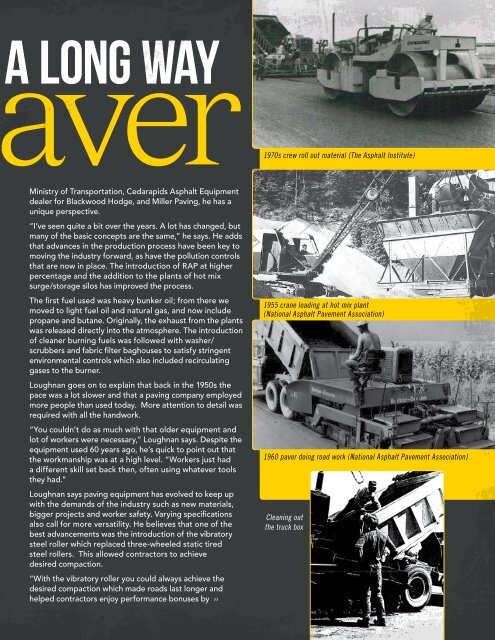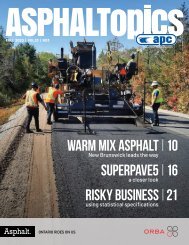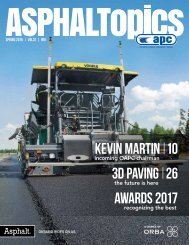ASPHALTopics | Summer 2014 | VOL 27 | NO3
Create successful ePaper yourself
Turn your PDF publications into a flip-book with our unique Google optimized e-Paper software.
a long<br />
ver<br />
way<br />
Ministry of Transportation, Cedarapids Asphalt Equipment<br />
dealer for Blackwood Hodge, and Miller Paving, he has a<br />
unique perspective.<br />
“I’ve seen quite a bit over the years. A lot has changed, but<br />
many of the basic concepts are the same,” he says. He adds<br />
that advances in the production process have been key to<br />
moving the industry forward, as have the pollution controls<br />
that are now in place. The introduction of RAP at higher<br />
percentage and the addition to the plants of hot mix<br />
surge/storage silos has improved the process.<br />
The first fuel used was heavy bunker oil; from there we<br />
moved to light fuel oil and natural gas, and now include<br />
propane and butane. Originally, the exhaust from the plants<br />
was released directly into the atmosphere. The introduction<br />
of cleaner burning fuels was followed with washer/<br />
scrubbers and fabric filter baghouses to satisfy stringent<br />
environmental controls which also included recirculating<br />
gases to the burner.<br />
Loughnan goes on to explain that back in the 1950s the<br />
pace was a lot slower and that a paving company employed<br />
more people than used today. More attention to detail was<br />
required with all the handwork.<br />
“You couldn’t do as much with that older equipment and<br />
lot of workers were necessary,” Loughnan says. Despite the<br />
equipment used 60 years ago, he’s quick to point out that<br />
the workmanship was at a high level. “Workers just had<br />
a different skill set back then, often using whatever tools<br />
they had.”<br />
Loughnan says paving equipment has evolved to keep up<br />
with the demands of the industry such as new materials,<br />
bigger projects and worker safety. Varying specifications<br />
also call for more versatility. He believes that one of the<br />
best advancements was the introduction of the vibratory<br />
steel roller which replaced three-wheeled static tired<br />
steel rollers. This allowed contractors to achieve<br />
desired compaction.<br />
“With the vibratory roller you could always achieve the<br />
desired compaction which made roads last longer and<br />
helped contractors enjoy performance bonuses by ››<br />
1970s crew roll out material (The Asphalt Institute)<br />
1955 crane loading at hot mix plant<br />
(National Asphalt Pavement Association)<br />
1960 paver doing road work (National Asphalt Pavement Association)<br />
Cleaning out<br />
the truck box


















